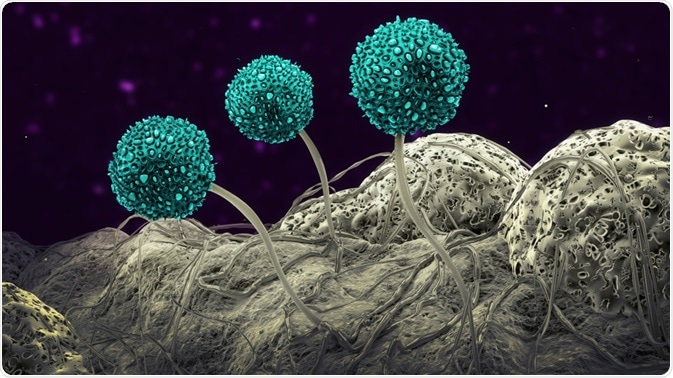A research team from the Harvard Medical School have developed a DNA-barcoded microbial system that can be used to determine an object’s provenance. This method is scalable, economical and reliable, as well as being compatible with a Cas13A RNA-guided nucleic acid detection assay, expanding its range of applications.
 Image Credit: Christoph Burgstedt / Shutterstock.com
Image Credit: Christoph Burgstedt / Shutterstock.com
The work addresses the issue of food provenance caused by the globalization of supply chains. Challenges with origin determination include the variation in the abundance of microbial communities, similar microbial compositions in convergent locations, and the labor and time-intensive nature of natural environments.
These challenges were bypassed by Qian’s team through the introduction of synthetic microbial spores bearing ‘barcodes’ indicating locations of interest; namely food production environments.
The translatability of this system in practice was verified through the successful meeting of several criteria. These include microbial compatibility with industrial-scale growth; biocontainability of spores to avoid adverse economic
Microbes as markers of object provenance
Knowledge of the origins of manufactured goods and agricultural produce is essential to ensure safety; with a range of implications – from tracing foodborne illness to complementing fingerprinting and video surveillance.
A barcoded microbial spores (BMS) system represents a scalable, safe, and sensitive method of determining the provenance of objects. It harnesses the natural ability of spores to persist for long periods without growth.
Qian et al. integrated engineered nonredundant DNA barcodes into Bacillus Subtilis and Saccharomyces cerevisiae spores to create a set of BMS to be used in combination to produce identification codes.
Microbe spores: the prefect medium for barcode delivery
Spores are formed in response to harsh environmental conditions enabling microorganisms to remain dormant for extended periods of time. This is a selective survival advantage under extreme conditions. Spores represent a biologically relevant medium as they can survive effectively under harsh conditions of real-world environments.
Techniques for manufacturing BMS at scale include standard cloning and culturing, and by spraying surfaces can be inoculated and BMS transferred to objects that come into contact with that surface. To identify barcodes, DNS can be lysed and subject to a recombinase polymerase amplification method, coupled with a nucleic acid detection method.
Following quantitative polymerase chain reaction and sequencing, barcodes can be deciphered.
Qian et al. used strains that require amino acids implementation for their growth. To ensure spores remained dormant, cells were germination deficient. This was achieved by deleting genes encoding germinant receptors and enzymes that degrade the cell wall. Collectively, this ensures that the BMS did not affect the native environment in which they are placed. Effectively, the synthetic DNA sequences are inert.
Engineering microbial barcodes
S. cerevisiae were also made germinant deficient. The antibiotic resistance genes that were used to produce the BMS were removed to prevent horizontal gene transfer of antibiotic resistance genes. The final inserted barcode does not confer any fitness advantage if horizontally transferred.
The group designed a series of DNA barcodes engineered for insertion into microbes. To test the specificity of the barcode design, 22 bar codes were constructed, and all permutations were assayed using an RPA method. This RPA method uses CRISPR technology to detect the presence of a genetic target.
Scaling the system was achieved using a rapid method devised by the team.
Verifying microbial barcode efficacy
The team examined the efficacy of BMS by conducting several experiments. Plants were grown in the lab and sprayed with several bar codes spores. A week after inoculation samples were taken from the leaf and soil.
All the samples were positively detected except for the two plants that had received variant group barcode sequences, demonstrating the specificity of detection.
To simulate cross-association that can occur during food processing, leaves from plants that were inoculated with a specific BMS per plant were mixed. Transfer was detected; however, the sequencing method could categorically distinguish the origins of each leaf.
Resilient microbes
Spores were tested for their robustness to demonstrate the applicability of their technique to real-world food supply chain. Plants inoculated with Bacillus thuringiensis (Bt) could be correctly identified (38 total).
Moreover, Bt spores remained detectable even after washing, frying, boiling, and microwaving demonstrating its ability to detect the provenance of cooked foods. The resilience of spores was compounded by evidence that revealed the persistence of barcoded microbes on soil, wood, carpet and sand.
Real-world applications of barcoded microbial spores
When the team constructed a sandpit to test the effects of environmental perturbations such as weather and physical disturbances, barcoded microbes continued to remain detectable and traceable.
Transfer onto objects passing through environments inoculated with BMS spores were simulated by transfer onto shoes worn in the inoculated sandpit; the BMS was detectable after walking on barcoded microbe-free surfaces for several hours.
These non-inoculated surfaces did not test positive for BMS, suggesting that barcoded microbes can continue in their environment without marked spreading, and may be transferred to objects passing through. They are subsequently retained on these and therefore can be detected specifically using SHERLOCK, the Cas13a RNA-guided nucleic acid detection assay
Qian et al. conclude “This system could also provide time-resolved information about location history, making it useful for an even wider range of applications.”
Sources
Qian, J. et al. (2020) Barcoded microbial system for high-resolution object provenance. Science.DOI: 10.1126/science.aba5584
Further Reading